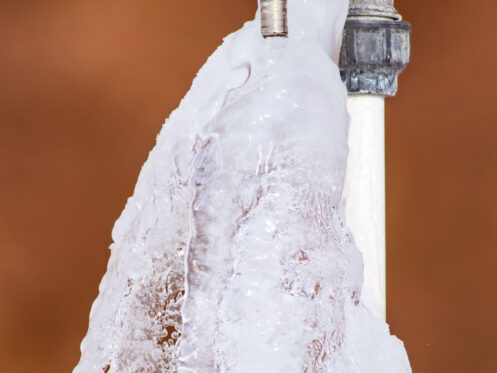One of the most common wintertime plumbing problems is frozen pipes. A frozen pipe can easily become a burst pipe, and that is something to avoid – especially in the middle of the night or while you are away, which is when your plumbing system is typically most susceptible to freezing temperatures. Luckily, there are easy steps you can take to prevent this plumbing problem from becoming a plumbing disaster.
Stop Your Frozen Pipe Problem From Becoming a Plumbing Disaster
Catch and prevent frozen pipes before they burst and require expensive repairs. 3 Mountains Plumbing wants to help you save money this winter, so follow these precautionary steps!
Step 1: Pinpoint vulnerable pipes.
The first step in winterizing your plumbing system is to identify any areas of your home where the plumbing is vulnerable to freezing temperatures. The areas to investigate include:
- Exterior walls (especially those with little to no insulation)
- Unheated basements
- Garages
- Crawl spaces
If you have these types of spaces in your home, you’ll want to look for and address any exposed or leaky pipes.
If you are unsure of where your trouble spots are, you might want to call a plumbing repair service for a professional assessment and assistance. This way you can get a complete overview of what you need to take care of and what to look out for over the winter.
Step 2: Drain exterior plumbing systems.
Once you’ve determined where winterizing is needed, begin by securing exterior pipes and faucets that won’t be used during the winter. Any water that becomes trapped in these pipe systems can freeze and expand, leading to cracks, breaks, or burst pipes.
Outdoor faucets (aka ‘hose bibs’). Before freezing weather hits, drain and disconnect all garden hoses. Leaving hoses attached can cause a small amount of water to remain in the spigot pipe, which will quickly freeze. Install a hose bib or faucet cover to insulate and protect the faucet from freezing temperatures.
Lawn irrigation systems. If you have an irrigation system, shut off any water flowing into it and completely drain any remaining water from the pipes. If you’re not sure how to do this, it may be best to call a plumbing repair service or irrigation company for assistance.
Step 3: Weatherproof trouble areas.
Next, you can move on to exterior areas with exposed plumbing, or those that lead into areas with exposed plumbing, such as crawl spaces or your basement. Wherever possible, check all doorways, windows, and vent fans to ensure seals remain tight and are not coming loose or separating in any way. If you notice any spaces in the window or doorframes, you can seal these up with caulking. Be sure to repair any cracked windows too.
Step 4: Insulate exposed pipes.
In certain areas of your home, you don’t want to seal off the airflow completely because this can encourage mold growth. Instead, you’ll want to insulate the pipes themselves so they’ll be safe against any cold air that gets in.
It is fairly easy and inexpensive to insulate pipes – all you usually need is some foam tubing or even towels or rags to wrap around the pipes. Insulating your pipes, especially the hot water pipes, is a great idea in general, as it can lighten the load on your water heater and thus reduce your energy bills.
If you have pipes vulnerable to freezing and located near an electrical source, you might want to look into using electrical heating tape to keep the pipes above freezing temperatures. Heat tape is intended to be wrapped around the pipe and when plugged in, it will put out just enough heat to keep the pipes warm.
Step 5: Keep indoor pipes warm.
While outdoor pipes are more likely to become the source of wintertime plumbing problems, it’s also a good idea to pay some attention to your indoor plumbing as well. When temperatures drop to freezing levels, you might want to open cabinet doors to expose the indoor pipes to your home’s heating system.
If you will be away from your home during cold weather, keep your interior thermostat set to at least 55 degrees Fahrenheit. Should the outside temperature drop below 30 degrees, you may even want to allow your kitchen or bathroom faucets to drip steadily. While leaky pipes should always be addressed promptly, allowing faucets to drip can help ward off bigger plumbing problems due to freezing.
To avoid freezing pipes, you should winterize your plumbing system as soon as outdoor temperatures start to drop in the fall or wintertime. As long as you get to the pipes before the freezing temperatures do, you can take great strides toward preventing burst pipes and other large-scale plumbing problems. Call 3 Mountains Plumbing today!

